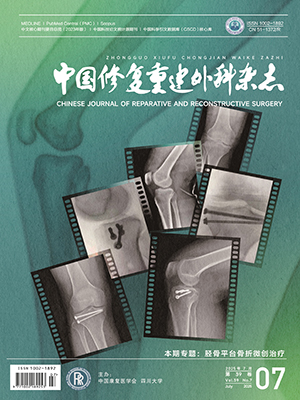To evaluate the implantation effect of artificial vascular grafts with recombinant fibrinolytic enzyme factor II (rF II)-immobil ized lumina in animal test. Methods Four mm internal diameter (ID) polyurethane (PU) artificial vascular grafts were prepared by di pping and leaching method. The micro-pore size and morphology of the graft walls were observed by SEM. The graft lumina were immobil ized with rF II. Twenty hybrid male dogs [weighing (20 ± 1) kg] were used for animal model of carotid artery defect and were randomly divided into 3 groups: rF II -immobil ized PU group, no rF II -immobil ized PU group and expanded polytetrafluoroethylene (ePTFE) group. The vascular grafts were implanted for repairing injured segments of carotid artery in dogs. The general health state of animals was recorded. At 30 days and 60 days,
the patency rate of every group was calculated. At 60 days IDs were measured, cell prol iferation in neointima was inspected by l ight microscope, morphology on neointima was observed by SEM. Results The ID of the PU vascular grafts was (3.74 ± 0.06) mm, wall thickness was 0.4-0.6 mm, the wall density was 0.25 g/cm3, the porosity was 79.8%, racical compl iance was 8.57%/100 mmHg. In the wall, micropores were well distributed and opened-pores structure was observed. Pore size was (140 ± 41) μm in the outside layer, pore size was (100 ± 3) μm in the inside layer, thickness ratio of outside / inside layers was 2 ∶ 1, the pore size was (40 ± 16) μm on the lumina surface. After operation the wounds on neck healed, all the animals survived and had no compl ication. At 30 days and 60 days after implantation, the patency rate for rF II -immobil ized PU group were 100% and 66.7%, for no rF II -immobil ized PU group were 66.7% and 33.3%, and for ePTFE group were 67.7% and 0 respectively, but at 60 days there were thrombosis at anastamotic sites of some grafts occluded. Before operation the IDs for rF II-immobil ized PU group, no rF II -immobil ized PU group and ePTFE group were (3.74 ± 0.06), (3.74 ± 0.06) and (4.00 ± 0.03) mm, at 60 days after operation the IDs were (4.51 ± 0.05), (4.31 ± 0.24) and (4.43 ± 0.12) mm respectively, showing no statistically significant differences between 3 groups (P gt; 0.05). Histological inspection indicated that at 15 days a layer of plasma protein deposited on the lumina, at 30 days some cells adhered to the lumina, at 60 days neointima could be observed on the lumina. Thickness of the neointima became larger with implantation time. At 60 days neointima thickness at proximal end, middle site and distal end of
graft were (560 ± 22), (78 ± 5) and (323 ± 31) μm respectively for rF II -immobil ized PU group. The results of SEM showed that neointima surface consisted of flat and long cells which long axes ranged with blood flow direction and was similar to lumina morphology of carotid artery of dog. Conclusion Immobil ization of rF II to lumina of grafts could enhance fibrinolytic activity and inhibited formation of thrombo-embol ia which led to an increase in patency rate after implantation.
Citation: PAN Shirong,YIN Shengli,YAO Jianping,ZHENG Huanling,YI Wu,DAI Gang.. TEST OF CAROTID ARTERY REPLACEMANT BY POLYURETHANE ARTIFICIAL VASCULAR GRAFT WITHRECOMBINANT FIBRINOLYTIC ENZYME FACTOR II-MODIFIED LUMINA IN DOGS. Chinese Journal of Reparative and Reconstructive Surgery, 2008, 22(7): 832-838. doi: Copy
Copyright © the editorial department of Chinese Journal of Reparative and Reconstructive Surgery of West China Medical Publisher. All rights reserved




